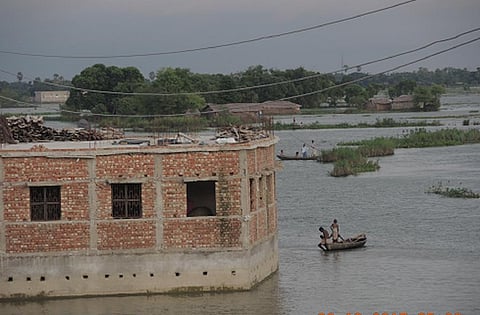Kosi: How ‘Bihar’s sorrow’ moulds villages across her vast fan, year after year
Villages on the banks of the Kosi in north Bihar are surprisingly different from anywhere else as they are prone to floods.
A village settlement in the Kosi region resembles a nucleated circular shape, with most safe houses located in the centre. Cattle are usually kept in sheds mostly built along with the dalaan, a hut with open entries from all sides.
Men and children mostly use dalaans for taking rest, sleeping, studying, playing cards and social gatherings. These dalaans host all but the females. Thus, they are male spaces yet very useful and vibrant.
A typical village in Kosi is generally elevated from its surroundings and may or may not be connected through roads. Houses have front yards called angan and a backyard called baadi, also used for growing seasonal vegetables, flowers and fruits.
The front yard is generally fenced with bamboo, tall grasses and manejara, a leguminous plant used to fence walls. The front yard fencing is for the convenience of the married women who otherwise need to put on their ghunghat (veil) out in the open, in front of older male relatives and elderly females.
New brides need to pay special attention to live in these villages if they are not from flood-prone areas, as an unexpected flood may give them a shock when they face it for the first time.
Small hamlets have closely related families and households belonging to the same caste. In big villages, different communities coexist, but their location depends on their settlement history, caste, class and religion.
People from the most influential castes and classes occupy the central and safest space in the village, while those from lower castes are marginalised to the edges.
The places of worship are located on higher grounds and close to water bodies such as ponds and ghats ( steps leading to rivers). Every village is connected to others through kutcha roads as pucca roads and bridges do not sustain floods.
Those villages in the badh-ban (outskirts) might just have paidal-margs (walkways), aaeer and dhoor (narrow and wide bunds in farmland). There are designated places for weekly market (hatiya) in big villages, often close to the school or college grounds.
These marketplaces are named after the days of the week and are located in the vicinity of five to 10 villages. Criss-cross junctions known as chowk-chauraha (four-way junctions) also act as daily marketplaces for essential items.
Around the villages and outside agricultural lands lies the gaachhi (private woodland), rivers and char-chanchad (wetland and marshy land which spread from one village to another).
Gaachhis are used to grow bamboo and other essential woody trees such as mango, jamun, sissoo and other useful trees for building homes and furniture. It also serves as a private cremation-cum-burial ground.
In the summer and winter, when the lands are dry, one can witness all the above-mentioned features in the village. But once the monsoon comes and the rivers flood, they disappear.
The villages endure this for at least a couple of months. When the monsoon gets stronger, the floodwater starts knocking on the doors, leaving no dry land for living.
Cattle are kept on high grounds and stall-fed with paddy straws, wheat husk and a little bit of green grass fetched from badh-ban, located on higher grounds.
During floods, special feeding pans (laidh) are used to feed cows and buffaloes while goats are given grass and leaves, tied above their khutta (wooden or metallic poles dug deep into the ground).
Also read: No plan to desilt Kosi: Bihar govt
People also move to the river embankments if the water level rises and reaches the level of beds in the houses. Floods determine the visibility of the physical features of a typical Kosi village.
It erases all the distinctions and makes everything around the village a vast pan of slowly moving murky water filled with fish, crabs and snails.
The common sights in floods are floating ant colonies, snakes, Bengal monitor lizards, rats, Silver back Jackals, Small Indian foxes and other animals swimming towards the safety of dry lands and trees.
Also, we can see parents desperately looking for their children and cattle, arranging for fuel wood to cook food and fetching drinking water from a few tube wells above the waterline.
Wandering around in dirty flood water for days leaves a permanent scar on the feet, giving an itchy sensation and infections in the feet. Finding a dry space to rest and sleep becomes a rare commodity; forget about sleeping peacefully.
Mosquitoes, other insects and dangerous creatures, such as snakes and scorpions displaced by floodwater, keep coming towards people’s settlements, especially at night.
In these times, keeping oneself dry and safe from wild creatures becomes a challenge and getting cooked food and safe drinking water a luxury.
Day-to-day activities, hygiene and sanitation become very challenging in these villages, especially for those without access to boats. Those who have boats also need to be very careful. Women go in groups on boats to relieve themselves, while men and children go separately.
Views expressed are the author’s own and don’t necessarily reflect those of Down To Earth

